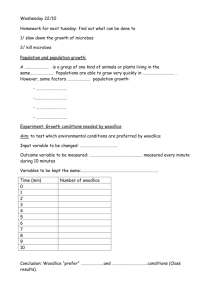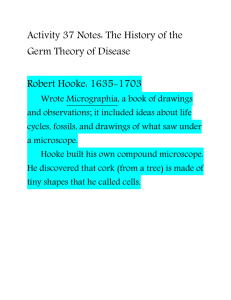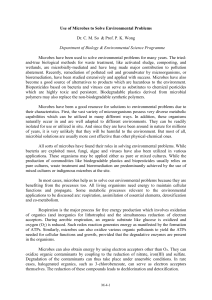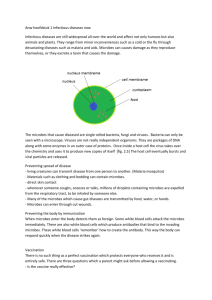Lesson 1 Homework for next Tuesday (28/11): find out what can be
advertisement
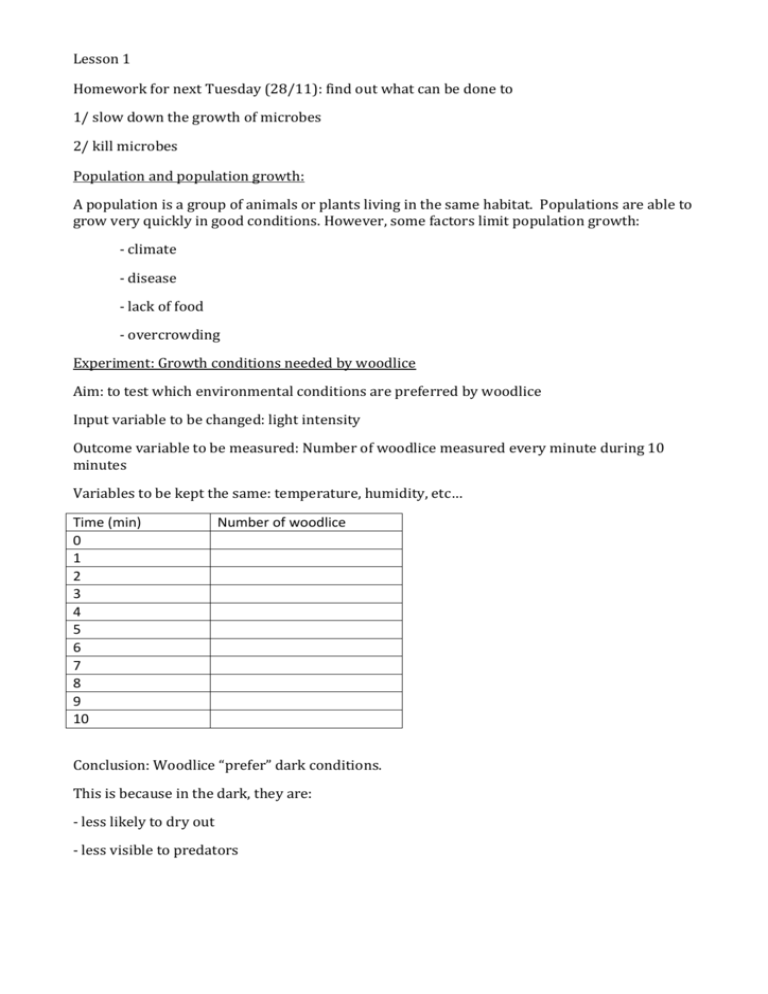
Lesson 1 Homework for next Tuesday (28/11): find out what can be done to 1/ slow down the growth of microbes 2/ kill microbes Population and population growth: A population is a group of animals or plants living in the same habitat. Populations are able to grow very quickly in good conditions. However, some factors limit population growth: - climate - disease - lack of food - overcrowding Experiment: Growth conditions needed by woodlice Aim: to test which environmental conditions are preferred by woodlice Input variable to be changed: light intensity Outcome variable to be measured: Number of woodlice measured every minute during 10 minutes Variables to be kept the same: temperature, humidity, etc… Time (min) 0 1 2 3 4 5 6 7 8 9 10 Number of woodlice Conclusion: Woodlice “prefer” dark conditions. This is because in the dark, they are: - less likely to dry out - less visible to predators Lesson 2 Human population: Human population is now growing very quickly as many factors that used to limit the growth of our population are controlled in our modern life. Limiting factor Disease Overcrowding Lack of food Lack of water Means of control Bacteria and bacterial growth Microbes (also called micro-organisms) are organisms which are so tiny that they can only be observed using a microscope microscopic organisms Microbes include bacteria, fungi and viruses. Microbes can be found in air, soil and untreated water, on and in plants, on and in animals. Experiment: Which conditions are best for microbes to grow? Condition Freezing and dry Freezing and wet Cold (Fridge) and dry Cold (Fridge) and wet Class result Conclusion: Microbes grow the best in wet and damp conditions Lesson 3 Control of microbial population: Researched based lesson Encouraging population growth Some microbes are really useful for humans: Warm and dry Warm and wet Hot and dry Hot and wet Lesson 4 Recap of what was learnt last lesson in the form of a spider diagram Some microbes are decomposers: they can make dead things rot. Things that rot are called biodegradable, things that never rot are called non-biodegradable. Examples of biodegradable things: - apples - humans - wood - plants Examples of non-biodegradable things: - glass - metal - some plastics - cans In the lab, they are grown in nutrient broth. Limiting the growth of microbes Microbes cannot grow, or will grow very slowly in food which is: - kept in the fridge or the freezer - dry (packet of crisps, dried pasta) - vacuum packed (no air) - very salty (salted cod, crisps) Killing microbes In some places, all microbes have been killed in a process called sterilisation. A place or an object without microbes is called sterile (e.g. clean syringes). Microbes can be killed by: - heat (flame tools, boil water for more than 10 min) - pressure (pressure cooker = autoclave) Demo autoclave - chemicals (bleach, alcohol) - filtration (filters with microscopic holes) - radiations (UV light) Microbes are not killed by cold temperatures. Lesson 5 Record and discuss results from Mouldy bread experiment Competition : Give homework on dandelions When organisms have a need for the same limited resource, e.g. shelter and food for animals, competition takes place. For example, Robins compete for their territory, animals which compete for food with humans are called pests. Competition also happens between plants for light, water and nutrients. Exercise on keys Lesson 6: Experiment: Which weed is the best competitor? Weed Sample 1 Sample 2 Sample 3 Sample 4 Sample 5 Total Dandelion Plantain Daisies Conclusion: Lesson 7 Who eats whom in an environment? Food is energy A food chain shows the movement of energy between plants and animals. The arrow shows the direction of the flow of energy. For example: Meadow: grass Sea Rock pool: Tree: oak tree seaweed snail limpet caterpillar hedgehog seagull black bird Food web: A food web is made up of many interconnected food chains. cat Fox Owl Weasel Hedgehog Vole Rabbit Worm Snail Oak Grass leaves 1/ Please write down all the food chains that you can find in this food web (6) e.g. grass grass rabbit rabbit fox weasel fox Oak leaves vole weasel fox Oak leaves vole owl Oak leaves worm hedgehog fox Oak leaves snail hedgehog fox 2/ What would happen if all the voles disappeared? The weasel will not have as much food, they might start to die off. However, some will survive as they can also eat rabbits. 3/ What would happen if the voles were present but the owl disappeared? The owls would die as their only source of food as disappeared. In a food chain, energy is lost at each level because plants and animals have to use some of it to live. Grass Snail Hedgehog Energy Lesson 8 Food pyramids show the number of organisms at each level of the food chain Pyramids of numbers Pyramids of numbers show they number of organisms at each level of the food chain. Remember - you need lots of salads to feed one rabbit, lots of rabbits to feed one fox, lots of foxes to feed one eagle - therefore, the number of organisms decreases (goes down) as you go up the food chain - there are always less predators than prey, otherwise predators would starve to death! For example: grass rabbit fox Fox

